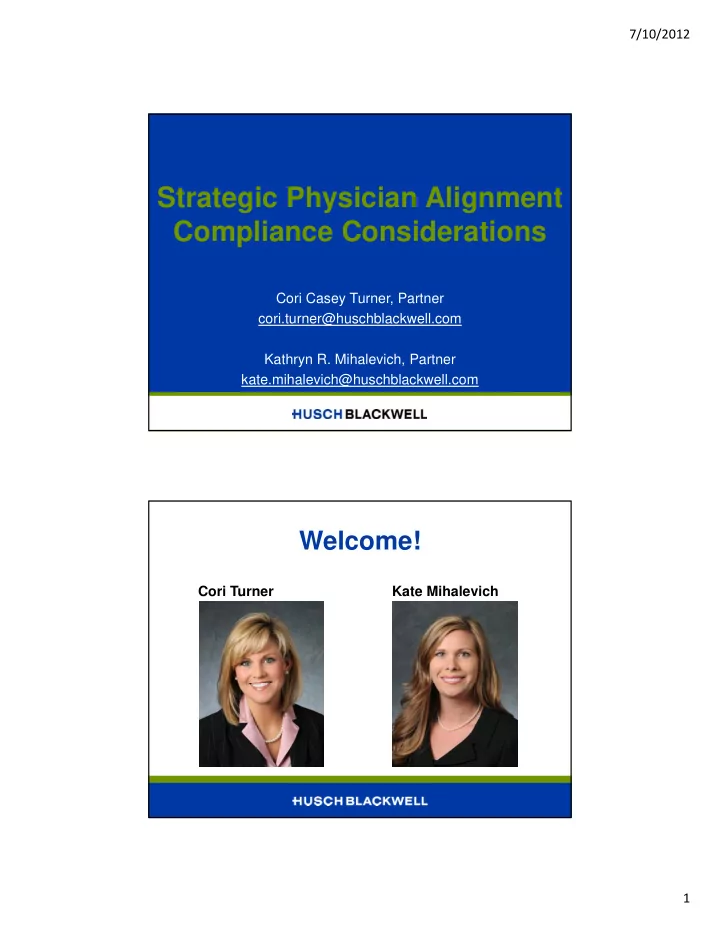

7/10/2012 Strategic Physician Alignment Compliance Considerations Cori Casey Turner, Partner cori.turner@huschblackwell.com Kathryn R. Mihalevich, Partner kate.mihalevich@huschblackwell.com Welcome! Cori Turner Kate Mihalevich 1
7/10/2012 Reminder: Non-Medicare ACOs ACO Medicare Waivers Do Not Apply to Non-Medicare ACO Models Fraud and abuse laws: - Stark - Anti-Kickback - Civil Monetary Penalties Law • Beneficiary Inducement • Gainsharing Internal Revenue Code restrictions related to tax-exempt organizations Anti-trust restrictions Compliance Implications Unique Compliance Issues Are Often Overlooked • Identify and assess pre-transaction • Not as commonly discussed in the industry; BUT do not result in less liability Address in Implementation Phase • Due diligence process • Audit considerations • Operationalization considerations Follow-up Review & Monitoring • Audit and monitoring considerations 2
7/10/2012 Title Auditing & Monitoring 3
7/10/2012 Compliance Implications: Compensation Considerations Personally Performed Services Stark Law requirement for employment relationships Limitation on credit for midlevel providers and ancillary services Increased risk with productivity-based compensation models - Midlevel services vs. physician services - Ancillary services inadvertently included Operational/ Audit considerations: - Semi-annual audits to identify ancillary credit concerns - Clear, defined process up front to address incident-to/ midlevel services – run sample calculations - Set physician expectations up front - Ensure contractual language is appropriate and reflects reality Applies to: traditional physician employment arrangements Compliance Implications: Compensation Considerations (Continued) Supervision of Midlevel Providers (MLPs) Appropriate to pay for personally performed supervision (employment) - Not paying for the work performed by the MLPs; paying for the physician’s supervision of the MLPs Consider state law supervision requirements - State law may limit the number of MLPs supervised Consider impact on physician’s practice Operational/ Audit Considerations: - Review state law and implement appropriate policies - Educate providers regarding supervision rules - Track compliance: semi-annual & random audits Applies to: Contractual models, employment, pseudo-employment 4
7/10/2012 Compliance Implications: Compensation Considerations (Continued) Quality Payments Great in theory, difficult to operationalize Define meaningful quality metrics – legitimate criteria - Participation vs. Results Ensure appropriate measurement tools (consistent and accurate) Fair market value implications Operational/ Audit Considerations - Enlist the assistance of a physician “champion” - Define plan and prioritize implementation (e.g., roll out by specialty) - Finalize and test quality program prior to implementation - Run sample reports at 3,6 or 9 months to determine if the data is being properly captured - Develop “stacking” valuation procedure / process Applies to: all integration models 5
7/10/2012 Compliance Considerations: Coding & Documentation Practices Far Reaching Compliance Revenue Opportunities Liability Increased Risk Under New Integration Models Operational/ Audit Considerations Billing Party - Implement audit process - Educate practitioners regarding processes (authentication, etc.) - Consider contractual provision addressing compliance with coding and documentation requirements Reassigning Party - Understand the billing process and reserve a contractual right to audit billing performance - Consider contractual provision regarding compliance with billing requirements Applies to: all integration models Compliance Implications: Contractual Payments Satisfying Contract Requirements –Payment Provisions Perhaps one of the biggest compliance risk areas because it is the most commonly overlooked “Technical” Stark violations Inadvertent errors can create substantial liability - Accounting department payment practices / processes - Clerical mistakes - Poor communication between hospital departments responsible for payment and execution of contractual terms Reconciliation paragraph - If payment error is discovered, the parties may reconcile error within stated timeframes. 6
7/10/2012 Compliance Implications: Contractual Payments (Continued) Operational/ Audit considerations: - Educate applicable personnel regarding legal requirements and consequences - Consider implementing payment approval process/ checks and balances - Audit physician contract payments Applies to : all integration models Compliance Implications: Joint Marketing Activities Joint Marketing Pitfalls Relates to collaborative relationships among providers Costs for joint marketing activities should be appropriately allocated - Consider allocation based on content dedicated to each party - Thoughtful, documented approach Operational/ Audit Considerations: - Communicate expectations and limitations - Educate marketing departments/related personnel - Consider approval policy (monetary threshold) - Set specific guidelines for use of logos and references to the parties 7
7/10/2012 Compliance Implications: Gainsharing May not directly or indirectly, induce a physician to reduce or limit services to Medicare or Medicaid beneficiaries under the physician’s direct care - Civil Monetary Penalty liability for both parties up to $2,000 per patient covered by the payments Waiver may exist for Medicare ACOs where certain requirements are met Implement safeguards noted in past OIG Advisory Opinions (transparency, physician payments tied to verifiable cost savings, applied irrespective of payor status, clinical safeguards to prevent inappropriate reductions in patient care) Applies to: Risk Sharing / Gainsharing Arrangements Practical Suggestion: Focus Your Resources Focus Y our Resources Utilize internal resources as much as possible Map the gaps/risk analysis - Communicate with senior leadership regarding resource shortfalls Acknowledge outside resources are available and may be necessary/ more efficient 8
7/10/2012 QUESTIONS? 9
Recommend
More recommend